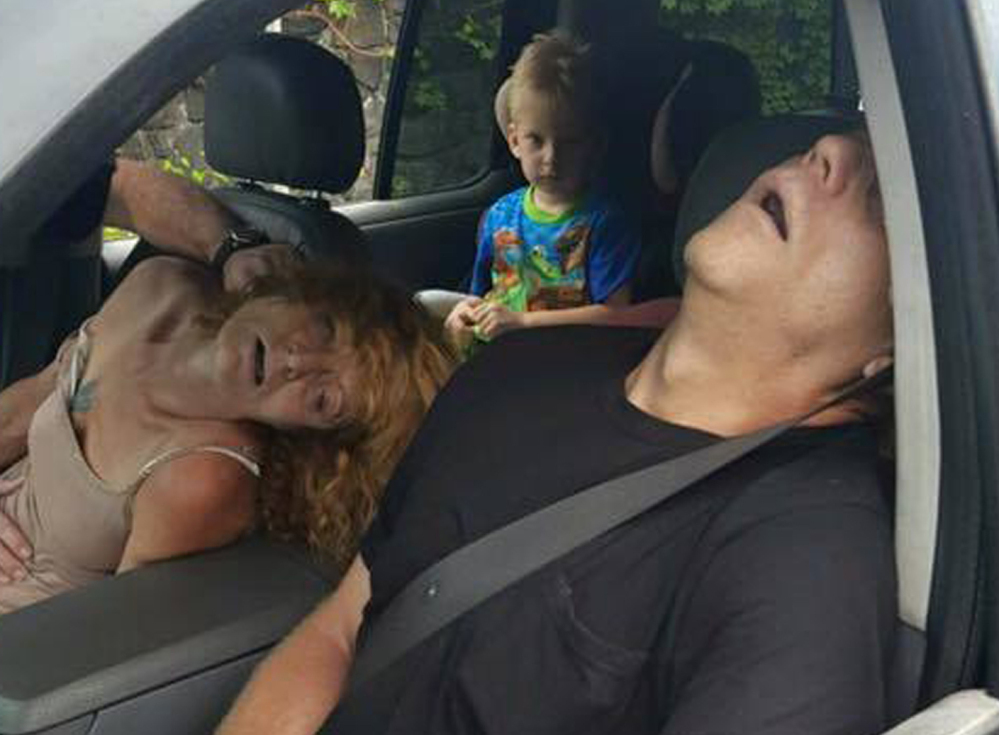On Wednesday afternoon, a police officer in East Liverpool, Ohio, stopped a vehicle for driving erratically and made a shocking discovery: The driver was barely conscious. A woman was slumped across the passenger seat next to him, turning blue.
In the back of the vehicle, a 4-year-old boy sat restrained in a car seat, according to a police report.
The officer called an ambulance, and when the EMTs arrived, they administered the life-saving drug Narcan, used to reverse opioid overdoses. After 47-year-old James Lee Acord and 50-year-old Rhonda Pasek were revived, police arrested them and contacted Columbiana County Children’s Services.
Acord pleaded no contest, and was sentenced to 180 days in jail on charges of driving under the influence and endangering children, according to a local news report. Pasek pleaded not guilty to charges of disorderly conduct, endangering children and a seat-belt violation.
It seemed like just another day of near-tragedy on the front lines of America’s opioid epidemic. But the East Liverpool incident was unique in one key respect: Someone at the scene snapped photos of the adults passed out in the car with the grim-faced child sitting in back. The city of East Liverpool then took the surprising step of posting those photos to its public Facebook page.
“It is time that the non drug using public sees what we are now dealing with on a daily basis,” the city wrote in the accompanying post. “We feel we need to be a voice for the children caught up in this horrible mess. This child can’t speak for himself but we are hopeful his story can convince another user to think twice about injecting this poison while having a child in their custody.”
The post has spread like wildfire on Facebook in the day since it went up, shared more than 22,000 times and eliciting more than 3,000 comments by Friday evening.
Commenters were split on the merits of the photo, with some saying the child’s face should have been blurred out, while others expressed gratitude to the city for showing what the effects of opioid use look like.
Brian Allen, the city’s director of public service and safety, said the city received a public records request for the photos from a local TV station. After discussion between Allen’s office, the mayor’s office and the city’s legal council, they decided to release the photos without blurring the child’s face.
Allen said authorities in East Liverpool, a city of 11,000 residents, are dealing with heroin-related cases on a daily basis.
“We had two overdoses yesterday,” he said. “Today we raided a dealer’s house and arrested a user.”
Ohio is in the throes of a heroin and opioid epidemic that shows no sign of abating. Last year, 3,050 people in Ohio died of drug overdoses, a new record.
The crisis affects all parts of the state, but it has been particularly severe in small cities such as East Liverpool, and in other rural areas in the eastern and southern parts of the state near the Ohio River. Once a mighty industrial artery for middle America, the Ohio River is now dotted with communities that have lost much of their economic strength as factories have closed and jobs have vanished.
East Liverpool is in Columbiana County, which ranks 57th among Ohio’s 88 counties on health outcomes, as measured by the County Health Rankings compiled by the University of Wisconsin and the Robert Wood Johnson Foundation. The rankings take many factors into account, including premature deaths, obesity and smoking.
Kathleen McCoy, a chemical dependency specialist at the Counseling Center of Columbiana County said that heroin is a big problem in the county. She said that there are resources to help people struggling with substance abuse, but that a big barrier is getting people to seek help.
She said when she looks at the photographs of Acord and Pasek, she sees a depiction of a terrible illness.
“I have an understanding of how addiction is a disease in the brain; it’s a chronic illness that can be treated,” McCoy said. “So you’re looking at two individuals, in the car with a child. And you’re looking at – once people get addicted, it’s more of a sickness that needs to be treated, versus these are terrible people.”
Allen, the public safety director,
Allen says more people need to understand what the front lines of that epidemic actually look like to the people responding to it.
“Sometimes the truth is hard to see,” he said, “and that’s what this photo is. The truth.”
Send questions/comments to the editors.



Success. Please wait for the page to reload. If the page does not reload within 5 seconds, please refresh the page.
Enter your email and password to access comments.
Hi, to comment on stories you must . This profile is in addition to your subscription and website login.
Already have a commenting profile? .
Invalid username/password.
Please check your email to confirm and complete your registration.
Only subscribers are eligible to post comments. Please subscribe or login first for digital access. Here’s why.
Use the form below to reset your password. When you've submitted your account email, we will send an email with a reset code.